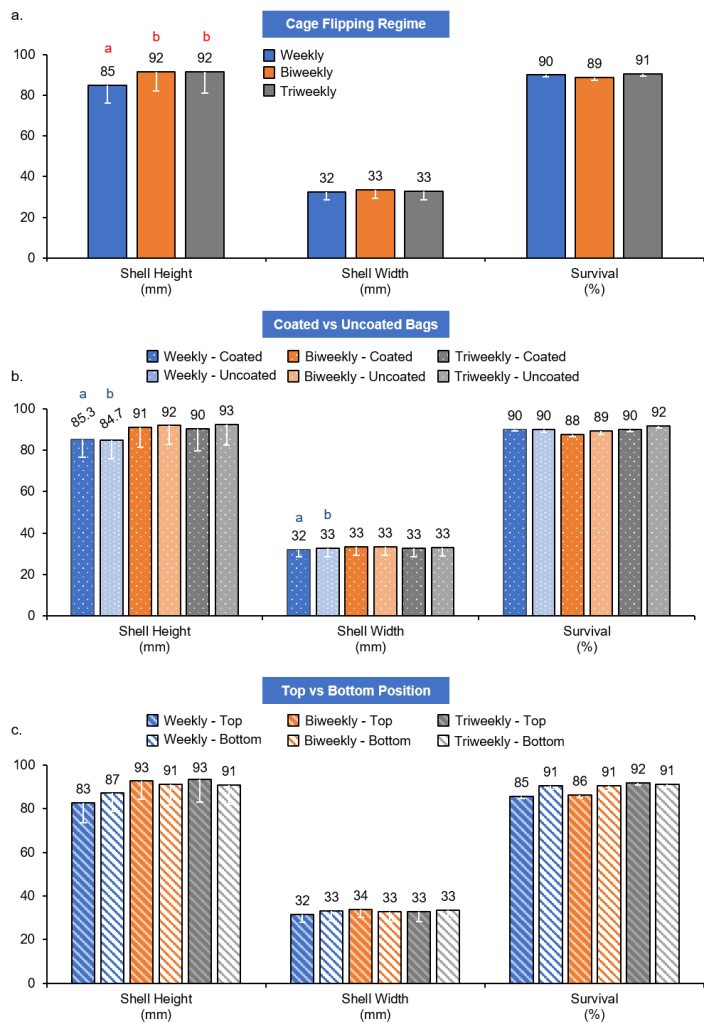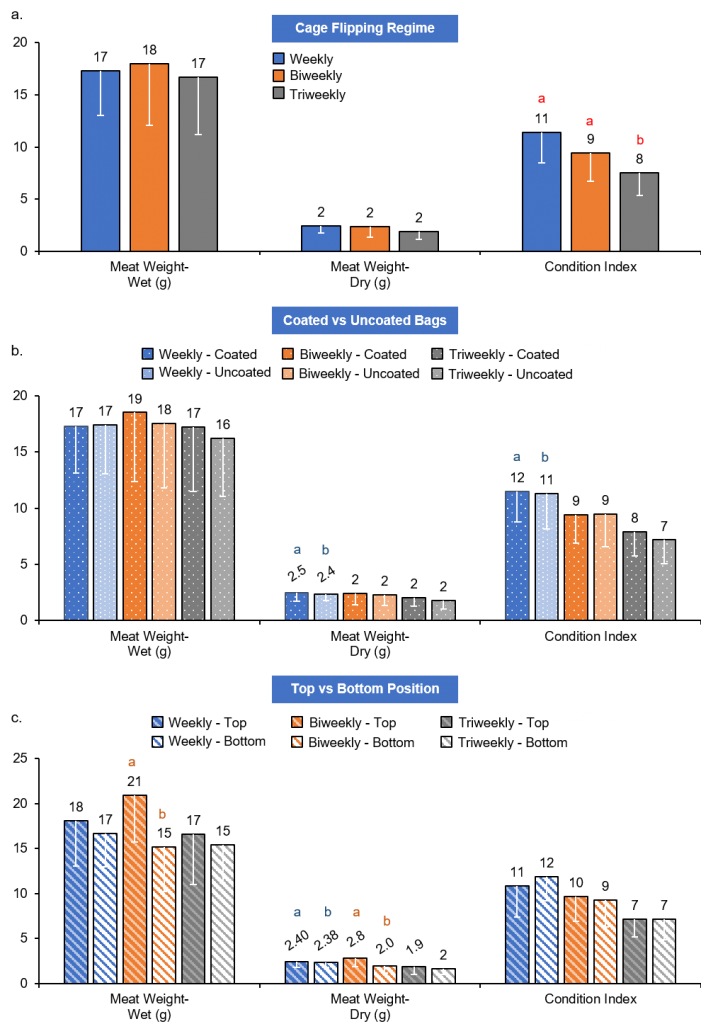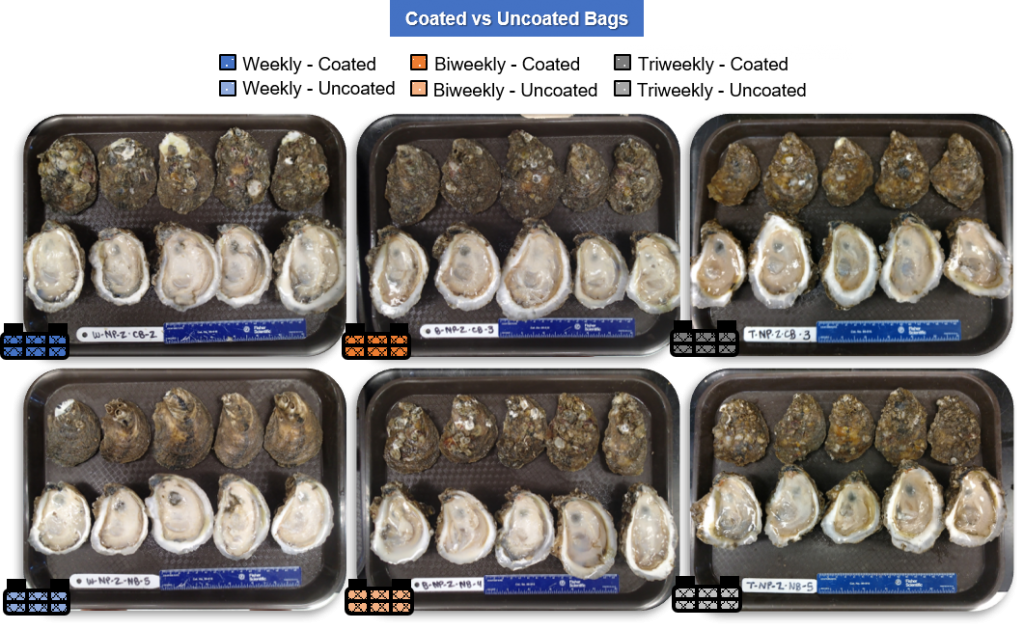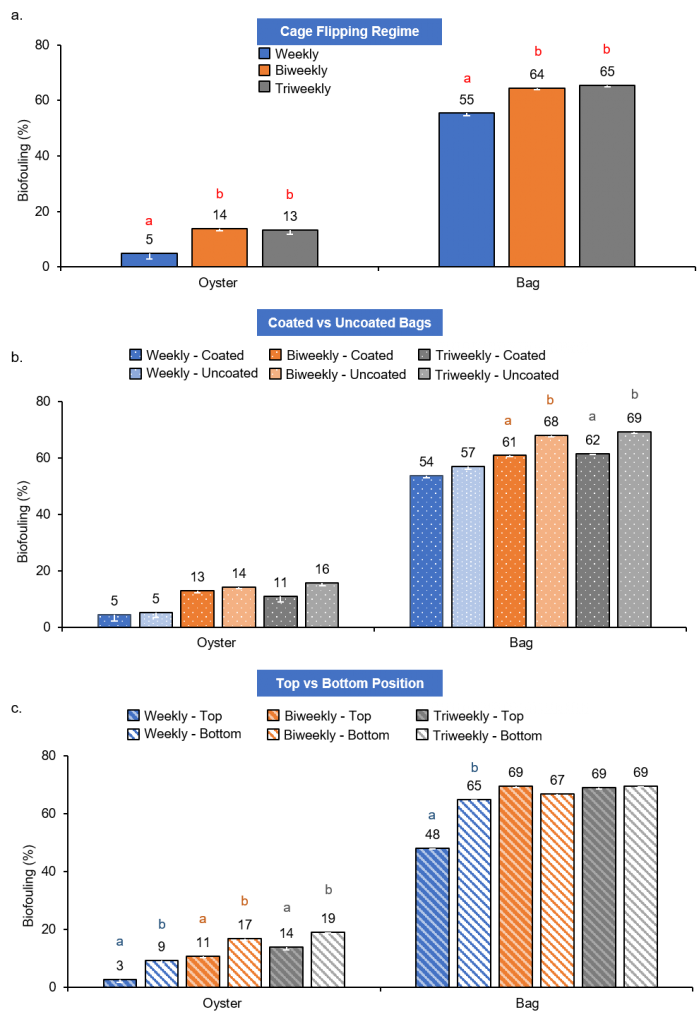Home » Other Oyster Culture Projects » Biofouling Control
Home » Other Oyster Culture Projects » Biofouling Control

Extension specialists partnered with commercial growers in the southern US to conduct field trials focused on developing maintenance strategies specific to off-bottom oyster production. Strategies included site-specific floating cage manipulation methods for controlling biofouling which negatively affects oyster production. The trials also included evaluation of a non-toxic antifouling coating to disrupt the adhesion of fouling organisms. By obtaining local data from seven states (North Carolina to Louisiana), site-specific guidance was developed to optimize production of high-quality oysters in the region. This article provides results from field trials conducted in Florida. Project funding was obtained through the USDA Southern Regional Aquaculture Center.
Methods
In June 2017, triploid oyster seed was produced at the Louisiana State University oyster hatchery in Grand Isle, LA and nursed for four months. Juvenile oysters were delivered to Florida in accordance with the Florida Department of Agriculture and Consumer Services’ rules pertaining to oyster seed importation; a diagnostic report and certificate of inspection by a licensed veterinarian was obtained. In late September (2017), triploid oysters were deployed at a commercial grower’s lease located in North Dog Island Aquaculture Use Area off Cedar Key. At that time, oysters measured 52 mm in shell height (SH), 39 mm in shell length (SL), and 16 mm in shell width (SW). Oysters were stocked into 14 mm Vexar bags at 150 per bag. Seventy-two bags were placed inside 12 six-slot floating cages (OysterGro®). Three aerial drying regimes, from now on referred to as “flipping” regimes, were followed allowing for evaluation of four cages each flipped weekly, biweekly, and triweekly (Table 1). Three bags with an antifouling coating and three uncoated bags were placed in each cage (Figure 1). Placement of bags in each cage (three on the top level and three on the bottom level) was also followed throughout the growout period (Table 1). The bag position was determined when the cage was in the drying position during aerial exposure (Figure 1).
Table 1. Summary of field trials evaluating biofouling management strategies for triploid oysters cultured in floating cages.

Figure 1. Position of bags in a six-slot floating cage in the growing (submerged) and drying (exposed) positions.

Aerial drying was achieved by flipping the cage from its growing position to the drying position, in which the cage was supported completely out of the water by 12” floats. During most of the growout period from September through April, floating cages were flipped back to their growing position after 24 hours. In May and June, however, cages were flipped in the late afternoon and then flipped back the following morning to avoid excessive heat.
Oysters were harvested after 8.5 months in June 2018, 12 months from spawning. Water temperatures from September through June (considered a “winter” growout period) averaged 70°F (Figure 2) and salinities averaged 26 ppt. At harvest, survival was determined by counting the number of live oysters per bag and dividing by the number stocked. Growth was determined by measuring 25 oysters from each bag for shell height, length, width, and total weight. In addition, ten of these oysters were frozen for later analyses of wet and dry meat weights, condition index, and biofouling. Pictures were taken to document appearance of external and internal shells as well as meats. The accumulation of biofouling on oysters and gear for each treatment was quantified. These data were statistically analyzed to determine the effects of cage flipping, bag antifouling coating, and bag position on oyster growth and survival; results were considered significant when probability values (p) were less than 0.05.
Figure 2. Water temperatures measured from September 2017 through June 2018 at the Dog Island Aquaculture Use Zone off Cedar Key, Florida.

Results: Survival and Growth
Flipping Regime
At harvest, survival was similar for oysters grown in cages regardless of flipping range with average values ranging from 89 to 91% (Figure 3a). Biweekly and triweekly flipped cages produced oysters with higher shell heights (92 mm) than those in weekly flipped cages (85 mm). Oysters in all cages had similar average shell length (66-68 mm) and shell width (32-33 mm). In the biweekly (127 grams, g) and triweekly (122 g) flipped cages, oysters had higher total weights compared to those in weekly flipped cages (111 g); whereas wet (17-18 g) and dry (1.9-2.4 g) meat weights were similar for oysters in all cages regardless of flipping regime (Figure 4a). Condition index was higher in oysters grown in weekly flipped bags (11.4) compared to biweekly flipped cages (9.4) and triweekly flipped cages (7.5). Condition index is a weight ratio that describes meat yield, in terms of dry meat weight and total wet weight with dry shell weight (equation below).
Bag Coating
Oysters grown in coated and uncoated bags placed in cages flipped biweekly and triweekly had similar survival, growth, weights, and condition index. Although statistical differences were found between oysters in coated and uncoated bags placed in cages flipped weekly, growers most likely would not find the differences in values for growth, weight, and condition index of commercial significance (Figures 3b and 4b).
Bag Position
Oysters in cages flipped weekly, biweekly and triweekly had similar survival, shell heights, shell lengths, shell widths, total wet weights, and condition index regardless of bag position (Figures 3c and 4c). Weekly and triweekly flipped cages produced oysters with similar wet and dry meat weights regardless of top or bottom position of the bags; however, oysters grown in bags placed in the top position of cages flipped biweekly had higher wet (21 g) and dry meat weights (2.4 g) compared to those in bottom position bags (15 g, 2.0 g) (Figure 4c).
In evaluating oysters grown in top bags only, shell lengths and widths, wet and dry meat weights, and condition index were similar regardless of flipping or coating treatments. Differences were found in the biweekly and triweekly flipped cages as oysters had higher shell heights (93 mm) and total weights (128-134g) compared to those in cages flipped weekly (83 mm, 109g). Oysters in cages flipped weekly (2.4) and biweekly (2.8) had higher dry meat weights compared to those in triweekly flipped cages (1.9 g). No differences among treatments were found in oysters grown in bottom position bags for shell growth, weights, and condition index.
Figure 3. Shell height, shell length and survival results for oysters cultured in floating cages evaluating a) flipping regimes, b) antifouling bag coating versus none, and c) bag position. Values with different letters indicate significant differences (p<0.05) among treatments.

Figure 4. Meat weight (wet and dry) and condition index results for oysters cultured in floating cages evaluating a) flipping regimes, b) antifouling bag coating versus none, and c) bag position. Values with different letters indicate significant differences (p<0.05) among treatments.

Results: Oyster Shell Shape and Meat Appearance
Shell metrics (height, length, width) are used to calculate fan and cup ratios to determine if the shell shape is appealing for the half shell market. Fan ratio is calculated by dividing the shell length by shell height and cup ratio is calculated by dividing shell width by shell height. Industry experts consider fan ratios above 0.66 and cup ratios above 0.33 to be favorable for oysters designated for the half shell market. Although oysters in all treatments exceeded the preferred fan and cup ratios, oysters in weekly flipped cages had significantly higher fan ratios (0.78) compared to oysters in biweekly (0.74) and triweekly (0.75) flipped cages. Similarly, cup ratios were higher in weekly flipped cages (0.38) compared to biweekly (0.37) and triweekly (0.36) flipped cages. Bag coating and position did not affect fan and cup ratios of oysters in all cages. Oyster meats cultured in floating cages flipped weekly appeared plumper, showed less stomach, and had greater shell fullness than those cultured in cages flipped biweekly and triweekly (Figure 5). This is also reflected in condition index differences obtained for oysters in the three flipping regimes.
Figure 5. Appearance of oyster meats harvested from coated and uncoated bags in floating cages flipped weekly, biweekly, and triweekly for biofouling control.

Results: Biofouling on Oysters
Flipping Regime
The field trials were conducted from September 2017 to June 2018, which is considered a “winter” growout as most of the culture period occurred over the cooler winter months. In Florida, biofouling is predominately a problem during the warmer summer months when environmental conditions enable fast oyster growth as well as fast growth of fouling organisms. To quantify biofouling in this study, oysters were weighed before and after removal of all fouling organisms from the shells, then wet meat weights were subtracted from total weights to determine percentage of fouling weight (see equation below). Oysters in biweekly and triweekly flipped cages had significantly higher biofouling (13%), greater than two times the amount found on oysters in weekly flipped cages (5%) (Figure 6a). The predominant fouling organism was barnacles, followed by naturally occurring (“wild”) oyster spat (Figure 5).
Bag Coating
The use of an antifouling coating on bags had no effect on oysters grown in cages flipped weekly, biweekly, or triweekly as the percent biofouling was the same for oysters in uncoated bags (Figure 6b).
Bag Position
Significantly higher biofouling occurred on oysters grown in bags placed on the bottom level of cages flipped weekly (9%), biweekly (17%), or triweekly (19%) when compared to oysters in bags placed on the top level of cages flipped weekly (3%), biweekly (11%), or triweekly (14%) (Figure 6c).
Figure 6. Percent biofouling on oysters and culture bags in floating cages evaluating a) flipping regimes, b) antifouling bag coating versus none, and c) bag position. Values with different letters indicate significant differences (p<0.05) among treatments.

Results: Biofouling on Culture Gear
Flipping Regime
Biofouling accumulation on the gear was quantified by weighing Vexar bags immediately after harvest and subtracting the weight from the corresponding pre-deployment bag weight expressed as a percentage of the bag weight at harvest (see equation below). Biofouling on the bags was significantly higher in biweekly and triweekly flipped cages (65%) compared to weekly flipped cages (55%) (Figures 6a and 7). Barnacles were the predominate fouling organism.

Bag Coating
The use of an antifouling coating on bags had no effect on biofouling in cages flipped weekly as values were similar (54-57%). In contrast, the uncoated bags in the biweekly (68%) and triweekly (69%) flipped cages had significantly, although slightly, higher biofouling compared to coated bags in the biweekly (61%) and triweekly (62%) flipped cages (Figure 6b).
Bag Position
Biofouling on bags placed on the bottom level of cages flipped weekly was significantly higher (65%) compared to bags placed on the top level of cages (48%). Bag coating had no effect on biofouling of bags regardless of position in cages flipped biweekly (67-69%) or triweekly (69%) (Figure 6c). When comparing all bags placed in the top position of cages, those in biweekly and triweekly cages had higher biofouling (69%) compared to weekly flipped cages (48%). No differences in biofouling were found on bags placed in the bottom position of cages regardless of flipping regime (65-69%).
Figure 7. Biofouling on bags at harvest from floating cages flipped weekly, biweekly, and triweekly for biofouling control.

Summary
Regardless of the management strategies evaluated in the Florida field trails, production of triploid oysters in all treatments was commercially acceptable. Survival was high (89-91%) over the 8.5-month culture period and oysters exceeded an average shell height of 3” (85-92 mm). The study could have ended earlier, but the project team wanted to observe how the cage flipping regimes, bag coating, and bag position affected biofouling as water temperatures warmed.
Shell heights and total weights of oysters were higher in the biweekly and triweekly flipped cages compared to the weekly flipped cages, most likely due to the increased handling and aerial exposure in the latter cages. However, oysters grown in the weekly flipped cages had the highest condition index (an indicator of meat to shell ratio) and cup and fan ratios (indicators of preferred shell shape). Further, shell biofouling was significantly less on these oysters than those harvested from the biweekly and triweekly flipped cages. Although most of the culture period occurred over the cooler winter months, the triweekly flipped cages became so heavy with biofouling that they could not be flipped during the last two scheduled times. If the field trials had extended any longer, most likely the cages would have sunk. Even the biweekly flipped cages were becoming difficult to flip. Consequently, weekly flipping of floating cages is recommended to minimize biofouling on gear and oysters in Florida growing conditions. Biofouling control during the summer months will require cages to be flipped in the late afternoon and flipped back the following morning to minimize exposure to high air temperatures.
The application of a biocide-free, antifouling coating on some of the bags was not effective in minimizing biofouling on oysters nor did it affect oyster production. Although there was a lower percent fouling (61-62%) observed on coated bags in the biweekly and triweekly flipped cages versus uncoated bags (68-69%), the differences most likely would not justify the coating costs.
The position of the bags in the cages had a significant effect on oyster meat weights (a sensitive measure of growth) and biofouling. Bags placed on the top level of the cage in the drying position were on the bottom level of the cages in the growing (submerged) position. In both the weekly and biweekly cage flipping regimes, oysters and bags placed on the bottom level had higher fouling than those bags which were more aerially exposed during the drying period. Likewise, oysters in these bags had higher wet and dry meat weeks as they tended to be in the water longer. These differences were not as pronounced in the cages flipped triweekly as bags on both levels were both equally submerged during the latter half of the culture period. Growers can offset these differences by switching positions of the bags in cages periodically.
A summary of data generated from these field trials, including averages and standard deviations of variables measured, and probability (p) values for the Kruskal-Wallis and post-hoc Dunn’s statistical tests, can be found here.

